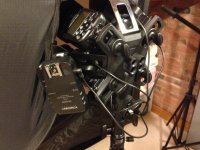I have a wall of sliding overlapping 4 ft wide insulation panels along one side of my usual shooting area that is at 90 degrees to my main 6 backdrop 10' wide system, and I have occasionally used these panels as a second backdrop. They are painted ceiling white on one side and flat black on the other. Their normal use is to block the morning and early afternoon Sun coming through the Southeast facing windows when this is needed, but they also block the view of my charging and printing areas from the usual shooting area. The printer and charging areas are on computer tables below these windows and the panel tracks are placed on the ceiling so that the panels slide just in front of the tables and block the view of these from the shooting area as well.
When I use these panels as a 2nd backdrop they are usually used with the white side facing the shooting area, but they can be removed from their sliding closet door tracks and returned to the tracks with the black side facing the shooting area. When using these as a second backdrop, I place additional lights for it, but they are set to be controlled by a second flash transmitter. Switching from shooting on my usual backdrops to shooting with these panels as a backdrop is then as easy as just switching flash transmitters on the camera. It can be done with one transmitter, but you have to turn all of the groups off for one backdrop and turn all of the groups on for the second backdrop. If you do this there is no need to change the transmitter operating channel, but using two transmitters and one channel with low and high groups set up on different transmitters much faster. Each light can be pre set for the levels needed for their respective backdrop, and all left with power on while only some work with one transmitter and others with the second transmitter. Even the subject/model remains in the same place and only needs to turn 90 degrees. Since I have one AC Power circuit feeding all of the lights, I can leave all of them powered, but only the groups for the backdrop that I'm using will fire with their respective flash transmitter. I could probably do this with different identifier settings or transmitter channels, but I always choose to use different transmitters for the separate the light control. I and the camera do need to move as well, so the camera is facing the 2nd backdrop.
I have two additional insulation panels that are not on the closet tracks, but also painted the same, and I use with them plywood floor stands that I built. These stands have a slot for the panel to fit into and they are also painted white/black. I can assemble and place these panels anywhere in the shooting area, much like using V Flats. I don't have a high enough studio ceiling for V Flats, so they won't don't fit in my studio. So I made my own shorter panel version that do fit my 8' ceiling studio. These panels are 4' wide and 7' 4" tall (to clear ceiling attached lighting).
My studio is in my home, in what had been a 2nd master bedroom suite. Being a relatively small space for a photo/video studio, I have designed and built it to be as flexible as possible. I can even do small videos in it without any major setup changes from still to video and back. I have a macro setup too. My shooting room is 19 X 26' with an 8' ceiling. It has been adequate for my need, but it is sometimes frustrating because of the low 8' ceiling. A 10 or 12' ceiling would have been better, but it wasn't financially possible at this location. My home's roof is directly above my studio (Maybe next time, next place).
Charley


